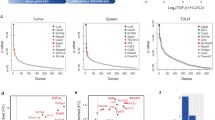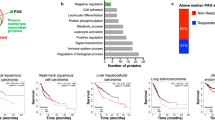Abstract
Crk-associated substrate lymphocyte type (Cas-L) is a docking protein that is heavily tyrosine phosphorylated by the engagement of β1 integrins in T cells. In the present study, we attempted to evaluate the role of Cas-L in the pathophysiology of adult T-cell leukemia (ATL). Examination of peripheral blood mononuclear cells from ATL patients as well as ATL-derived T cell lines showed an elevation of Cas-L in these cells. We showed that tyrosine phosphorylation as well as expression of Cas-L was markedly elevated through the induction of human T-lymphotropic virus type I (HTLV-I) Tax in JPX-9 cells, with these cells showing marked motile behavior on the ligands for integrins. We next performed yeast two-hybrid screening of cDNA library from an HTLV-I-transformed T cell line, which resulted in the identification of Tax as a putative binding partner for Cas-L. Co-precipitation experiments revealed that the serine-rich region of Cas-L might serve as the binding site with the highest affinity for Tax. Co-localization study showed that Tax and Cas-L partly merged in the cytoplasm. Finally, we showed that exogenous Cas-L inhibited Tax-mediated transactivation of nuclear factor κB (NF-κB), while Tax-independent activation of NF-κB remained intact, hence indicating that Cas-L might specifically regulate Tax-NF-κB pathway.
This is a preview of subscription content, access via your institution
Access options
Subscribe to this journal
Receive 50 print issues and online access
$259.00 per year
only $5.18 per issue
Buy this article
- Purchase on Springer Link
- Instant access to full article PDF
Prices may be subject to local taxes which are calculated during checkout







Similar content being viewed by others
References
Albrecht H, Shakhov AN and Jongeneel CV . (1992). J. Virol., 66, 6191–6193.
Alexandropoulos K and Baltimore D . (1996). Genes Dev., 10, 1341–1355.
Chun AC, Zhou Y, Wong CM, Kung HF, Jeang KT and Jin DY . (2000). AIDS Res. Hum. Retroviruses, 16, 1689–1694.
Cross SL, Feinberg MB, Wolf JB, Holbrook NJ, Wong-Staal F and Leonard WJ . (1987). Cell, 49, 47–56.
Durfee T, Becherer K, Chen PL, Yeh SH, Yang Y, Kilburn AE, Lee WH and Elledge SJ . (1993). Genes Dev., 7, 555–569.
Franchini G . (1995). Blood, 86, 3619–3639.
Fujii M, Niki T, Mori T, Matsuda T, Matsui M, Nomura N and Seiki M . (1991). Oncogene, 6, 1023–1029.
Fujii M, Sassone-Corsi P and Verma IM . (1988). Proc. Natl. Acad. Sci. USA, 85, 8526–8530.
Harhaj EW and Sun SC . (1999). J. Biol. Chem., 274, 22911–22914.
Hemler ME . (1990). Annu. Rev. Immunol., 8, 365–400.
Hynes RO . (1992). Cell, 69, 11–25.
Imura A, Hori T, Imada K, Ishikawa T, Tanaka Y, Maeda M, Imamura S and Uchiyama T . (1996). J. Exp. Med., 183, 2185–2195.
Inoue J, Seiki M, Taniguchi T, Tsuru S and Yoshida M . (1986). EMBO J., 5, 2883–2888.
Ishikawa T, Imura A, Tanaka K, Shirane H, Okuma M and Uchiyama T . (1993). Blood, 82, 1590–1598.
Ishino M, Ohba T, Sasaki H and Sasaki T . (1995). Oncogene, 11, 2331–2338.
Iwata S, Kobayashi H, Miyake-Nishijima R, Sasaki T, Souta-Kuribara A, Nori M, Hosono O, Kawasaki H, Tanaka H and Morimoto C . (2002). Eur. J. Immunol., 32, 1328–1337.
Juliano RL and Haskill S . (1993). J. Cell Biol., 120, 577–585.
Kim SJ, Kehrl JH, Burton J, Tendler CL, Jeang KT, Danielpour D, Thevenin C, Kim KY, Sporn MB and Roberts AB . (1990). J. Exp. Med., 172, 121–129.
Law SF, Estojak J, Wang B, Mysliwiec T, Kruh G and Golemis EA . (1996). Mol. Cell Biol., 16, 3327–3337.
Liu X, Elia AE, Law SF, Golemis EA, Farley J and Wang T . (2000). EMBO J., 19, 6759–6769.
Maruyama M, Shibuya H, Harada H, Hatakeyama M, Seiki M, Fujita T, Inoue J, Yoshida M and Taniguchi T . (1987). Cell, 48, 343–350.
Matsuyama T, Yamada A, Kay J, Yamada KM, Akiyama SK, Schlossman SF and Morimoto C . (1989). J. Exp. Med., 170, 1133–1148.
Minegishi M, Tachibana K, Sato T, Iwata S, Nojima Y and Morimoto C . (1996). J. Exp. Med., 184, 1365–1375.
Miura S, Ohtani K, Numata N, Niki M, Ohbo K, Ina Y, Gojobori T, Tanaka Y, Tozawa H and Nakamura M . (1991). Mol. Cell. Biol., 11, 1313–1325.
Miyake-Nishijima R, Iwata S, Saijo S, Kobayashi H, Kobayashi S, Souta-Kuribara A, Hosono O, Kawasaki H, Tanaka H, Ikeda E, Okada Y, Iwakura Y and Morimoto C . (2003). Arthritis Rheum., 48, 1890–1900.
Mori N, Mukaida N, Ballard DW, Matsushima K and Yamamoto N . (1998). Cancer Res., 58, 3993–4000.
Mori N, Sato H, Hayashibara T, Senba M, Hayashi T, Yamada Y, Kamihira S, Ikeda S, Yamasaki Y, Morikawa S, Tomonaga M, Geleziunas R and Yamamoto N . (2002). Blood, 99, 1341–1349.
Morita S, Kojima T and Kitamura T . (2000). Gene Ther., 7, 1063–1066.
Nagata K, Ohtani K, Nakamura M and Sugamura K . (1989). J. Virol., 63, 3220–3226.
Nojima Y, Humphries MJ, Mould AP, Komoriya A, Yamada KM, Schlossman SF and Morimoto C . (1990). J. Exp. Med., 172, 1185–1192.
Nojima Y, Rothstein DM, Sugita K, Schlossman SF and Morimoto C . (1992). J. Exp. Med., 175, 1045–1053.
Ohashi Y, Iwata S, Kamiguchi K and Morimoto C . (1999). J. Immunol., 163, 3727–3734.
Ohashi Y, Tachibana K, Kamiguchi K, Fujita H and Morimoto C . (1998). J. Biol. Chem., 273, 6446–6451.
Ruoslahti E and Reed JC . (1994). Cell, 77, 477–478.
Sakai R, Iwamatsu A, Hirano N, Ogawa S, Tanaka T, Mano H, Yazaki Y and Hirai H . (1994). EMBO J., 13, 3748–3756.
Sato T, Tachibana K, Nojima Y, D’Avirro N and Morimoto C . (1995). J. Immunol., 155, 2938–2947.
Sodroski JG, Rosen CA and Haseltine WA . (1984). Science, 225, 381–385.
Tachibana K, Sato T, D’Avirro N and Morimoto C . (1995). J. Exp. Med., 182, 1089–1099.
Tachibana K, Urano T, Fujita H, Ohashi Y, Kamiguchi K, Iwata S, Hirai H and Morimoto C . (1997). J. Biol. Chem., 272, 29083–29090.
Tanaka A, Takahashi C, Yamaoka S, Nosaka T, Maki M and Hatanaka M . (1990). Proc. Natl. Acad. Sci. USA, 87, 1071–1075.
Uchiyama T, Yodoi J, Sagawa K, Takatsuki K and Uchino H . (1977). Blood, 50, 481–492.
Uchiyama T . (1996). J. Clin. Immunol., 16, 305–314.
Yamashita I, Katamine S, Moriuchi R, Nakamura Y, Miyamoto T, Eguchi K and Nagataki S . (1994). Blood, 84, 1573–1578.
Yodoi J and Uchiyama T . (1986). Immunol. Rev., 92, 135–156.
Yoshida M . (1993). Trends Microbiol., 1, 131–135.
Yoshimura T, Fujisawa J and Yoshida M . (1990). EMBO J., 9, 2537–2542.
Zheng M and McKeown-Longo PJ . (2002). J. Biol. Chem., 277, 39599–39608.
Acknowledgements
We appreciate Yoshiyuki Ohashi, Rikako Miyake-Nishijima, Seiji Kobayashi, Kei Ohnuma, Masahiko Uchiyama, Rika Ouchida, and Noriaki Shimizu for help in some experiments. We greatly acknowledge Shoji Yamaoka for critical reading of the manuscript and invaluable discussion. This work was supported by grants-in-aid from the Ministry of Education, Science, and Culture and Ministry of Health, Labor and Welfare, of Japan.
Author information
Authors and Affiliations
Corresponding author
Rights and permissions
About this article
Cite this article
Iwata, S., Souta-Kuribara, A., Yamakawa, A. et al. HTLV-I Tax induces and associates with Crk-associated substrate lymphocyte type (Cas-L). Oncogene 24, 1262–1271 (2005). https://doi.org/10.1038/sj.onc.1208261
Received:
Revised:
Accepted:
Published:
Issue Date:
DOI: https://doi.org/10.1038/sj.onc.1208261
Keywords
This article is cited by
-
Expression of NEDD9 in pancreatic ductal adenocarcinoma and its clinical significance
Tumor Biology (2013)
-
Expression and clinical significance of NEDD9 in lung tissues
Medical Oncology (2012)
-
Integrin signalling adaptors: not only figurants in the cancer story
Nature Reviews Cancer (2010)
-
CAS proteins in normal and pathological cell growth control
Cellular and Molecular Life Sciences (2010)
-
The HTLV-1 Tax interactome
Retrovirology (2008)



